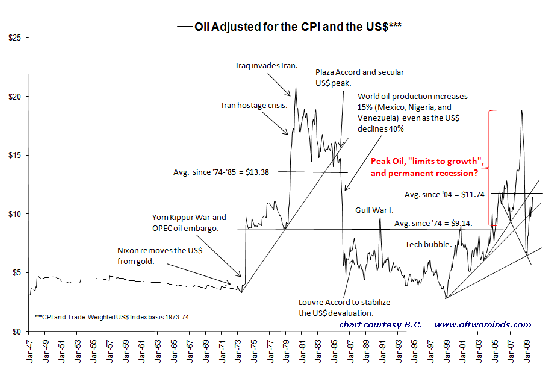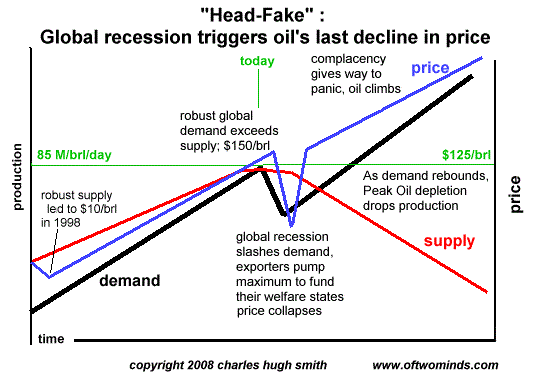Oil to $20/barrel or $200/barrel?
If the U.S. dollar strengthens and the global economy weakens as government stimulus runs dry, oil could plummet in a massive "head-fake" to $20/barrel. Survival+ is now available on amazon.com. Any discussion of the price of oil must factor in the relative value of the petro-dollar, a.k.a. the U.S. dollar. If the dollar plummets in value against other major currencies and gold, then oil could double in nominal price even as it remained constant when priced in other currencies or gold. Setting aside speculative positions, the other major factor in pricing oil is supply and demand. Recently, a spate of mainstream media article have heralded massive increases in supply in natural gas and oil. America's Natural Gas Revolution (WSJ.com) Betting Big on a Boom in Natural Gas (BusinessWeek) According to a July report by the Colorado School of Mines, the U.S. now holds 1,800 trillion cubic feet of natural gas, one third of it in shale, the equivalent of some 320 billion barrels of oil. That's more than Saudi Arabia's 264 billion barrels. Whew--now that we have more fossil fuel than Saudi Arabia, I guess we have nothing more to worry about. Uh, count me skeptical. The technological breakthough is calling "fraccing" for hydraulic fracturing, a technique which has been around for decades. Basically, water is used to fracture rock or shale, enabling the gas to seep to extraction wells. Chemicals pumped down the wells can also enhance recovery. All this sounds fabulous--except for the practicalities which are glossed over.How do you collect gas flowing into hundreds of widely spaced wells? With a network of pipes. That isn't quite as easy or cheap as dropping a pipe into a supergiant Saudi reserve. So how much will it cost to tap these giant reserves of gas and feed the gas into existing networks of transport? Exactly what chemicals are used? How much do they cost to pump down and extract? How do you get the water to the hundreds of wellheads? And perhaps most remarkably absent from the happy news--how much of this new natural gas production will simply be offsetting declines in other mature fields? Similar advances in oil recovery technologies promise another 100 years of oil--or so we are told here: Another Century of Oil? Getting More from Current Reserves (Scientific American October 2009; subscription required to read entire article online; visit your local library to read it for free) The author predicts that by 2030, thanks to advanced technologies, wells will be able to extract half of the oil known to be underground, up from the current average of 35 percent. Together with new discoveries, the increased productivity could make oil last at least another century. Once again, the article (written by a global oil company executive) is heavy on promise and glowing hype and short on costs. Is all this fancy recovery technology free? If not, then how much does it add to the extraction cost of each barrel? All this seems to suggest something which these articles avoid mentioning: there may be more fossil fuel that is recoverable, but it will no longer be cheap. None of these articles addressed the possibility that all this "new" production will simply offset declining production elsewhere, which means global production would simply stay constant rather than increase to match rising demand. Also left unsaid is the trivial amounts of oil and gas being recovered from aging fields by the costly new technologies. The example cited in the article is a large field in California that was expected to be depleted year ago which still produces 80,000 barrels a day. That is good news, to be sure, but the extraction only makes sense if oil is over $50 a barrel, and 80,000 barrels is a drop in the bucket of the 20 million barrels the U.S. uses each day. It would take dozens of such vast fields to replace the sagging production from supergiant fields in Mexico, the North Sea and the Mideast. With prices elevated to the $80/barrel level, constant supply (at high prices) has created a global glut in oil and natural gas--there are literally no storage facilities available to store more gas and oil. This suggests that if the global economy resumes its deflationary spiral down next year, then a grand imbalance between supply and dwindling demand might cause oil to crash in price--unless the U.S. dollar declined concurrently. As readers know, I am expecting the dollar to actually rise, which would exert downward pressure on the price of oil (in dollars, of course). Correspondent B.C. was kind enough to submit this chart and commentary.The chart displays the price of oil adjusted to the CPI (consumer price index) in which 1974=100. In other words, the price is in constant dollars, not nominal dollars; the chart removes inflation from the picture. Thus if today's dollar is worth 33 cents in 1974 dollars, then today's $3 a gallon gasoline would be $1 in 1974 dollars. Adjusted for inflation, we see oil at its recent nadir in 1999 had returned to the price levels of the late 1960s. The cost spike created by the 1980 Iraq-Iran war was actually higher in real terms than the spike last year to $147/brl. Here is B.C.'s commentary on how the dollar's rise or fall could drastically alter the price of oil. However, were the USD to rally back to the earlier cyclical high or to par, for example, coincident with another deflationary episode, the nominal price of oil would have to fall to the low to mid-$30s, to as low as the low to mid-$20s, to reach the adjusted recession low since the '90s and before the early to mid-'70s. That the nominal price of oil has generally tracked nominal trend GDP growth adjusted for the USD, all else equal, oil in the $20s would not surprise me over the next 1-5 years, especially if we see another deflationary scare and stock market crash and economic collapse in China-Asia. Thank you, B.C. If the dollar strengthens substantially, as many of us expect in the short-term, then oil would drop in nominal price for U.S. residents and increase for those paying for oil in other currencies. If deflation and global recession were to take hold--that is, if all the quantitiative easing and borrw-and-spend pump-priming fails to ignite "organic" (real) growth, then the price of oil could be hit with two deflators: the rise of the petro-dollar (USD) and a supply which greatly exceeds falling demand. I illustrated this "head-fake" drop in prices before the final arrival of Peak Cheap Oil in 2008: Many other observers are similarly alive to the possibility that oil could drop in nominal dollars to $20/barrel in a deflationary "head-fake" and then rise to $200/barrel once supply fell below demand and the dollar resumed its decline in purchasing power. Frequent contributor Cheryl A. submitted an excellent interview with oil analyst Stoneleigh on the Automatic Earth blog. Stoneleigh suggested that oil could fall to $20 and then subsequently rise to $500 per barrel once demand exceeds supply. What we need to keep in mind is the relative value in nominal dollars. If the dollar were to suddenly lose 2/3 of its value against gold and other currencies, oil would suddenly cost $200/barrel to U.S. residents even as it remained constant to those buying oil with other curencies. Inversely, if the dollar were to strengthen, oil could fall in half when priced in U.S. dollars and skyrocket when priced in other currencies. The main point is simple: tracking the price of oil in constant (adjusted) dollars illuminates the real cost of oil in purchasing power. Survival+ is now available on amazon.com. You can also find my work on AOL's Daily Finance and Seeking Alpha. Thank you, Susan M. ($5/month), for your exceedingly generous subscription to this site. I am greatly honored by your support and readership.In summer 2008 the U.S. and much of the rest of the world were consumed by talk of peak oil and natural gas and fears that high fuel prices would persist forever. Today analysts still worry about the oil supply but far less about natural gas. U.S. gas producers, capitalizing on a technological breakthrough, have in recent years unlocked an enormous volume of natural gas in the shale rock under Colorado, Oklahoma, Pennsylvania, Texas, and other states.
Forecasts that global oil production will soon start to decline and that most oil will be gone within a few decades may be overly pessimistic.

click on chart for a larger version in a new browser windowUS dollar (USD) and CPI constant, the nominal price of oil would need to fall back to the $40s to reach the CPI- and USD-adjusted level where recessions bottomed and new reflationary growth cycles commenced since the '90s.

Permanent link: Oil to $20/barrel or $200/barrel?
Apple iPod and iPhone owners: There is an Amazon Kindle app for iPhone which enables you to view the Kindle ebook on your iPod or iPhone--I will try to post links to the app once I locate them.
Buy the complete Survival+ in print or ebook formats.
Expanded free eBook now available: HTML: Survival+: Structuring Prosperity for Yourself and the Nation PDF version (85,300 words, 136 pages): Survival+)
Of Two Minds is now available via Kindle: Of Two Minds blog-Kindle























